14 Strangest Deep-Sea Creatures You Won’t Believe Exist
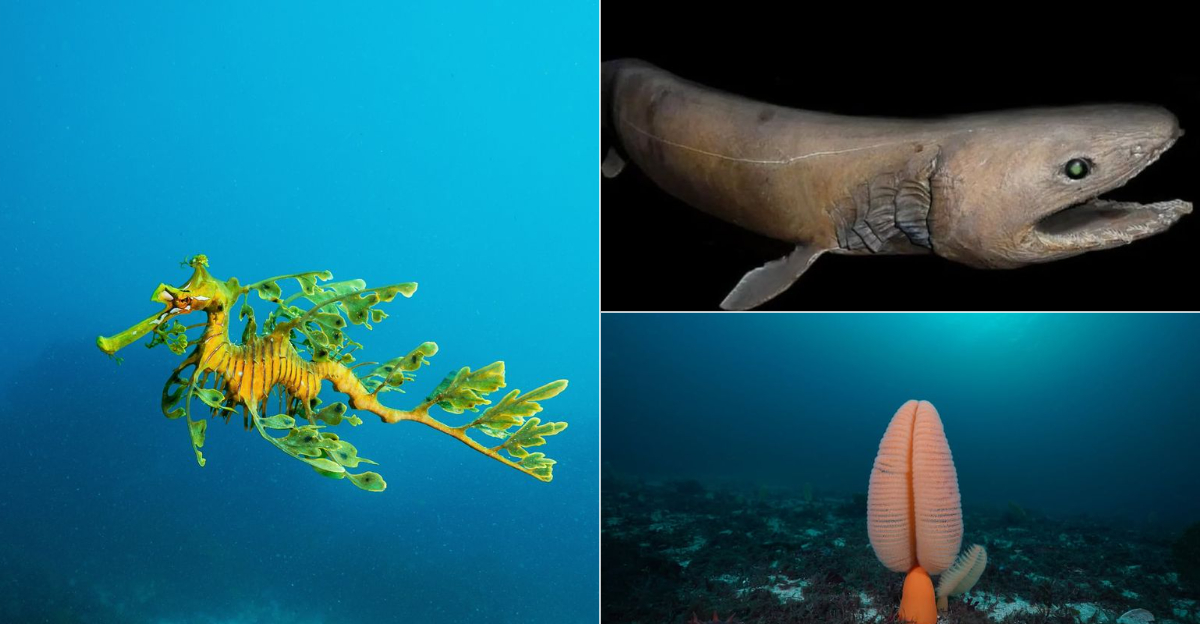
The ocean, covering more than 70% of our planet, holds mysteries beyond human imagination. Among these mysteries are bizarre and otherworldly creatures lurking in its depths.
Let’s check out some of the strangest deep-sea creatures that challenge the boundaries of belief and science alike. From the humorous to the horrifying, each of these unique beings offers a glimpse into the surreal world that exists beneath the waves.
1. Anglerfish
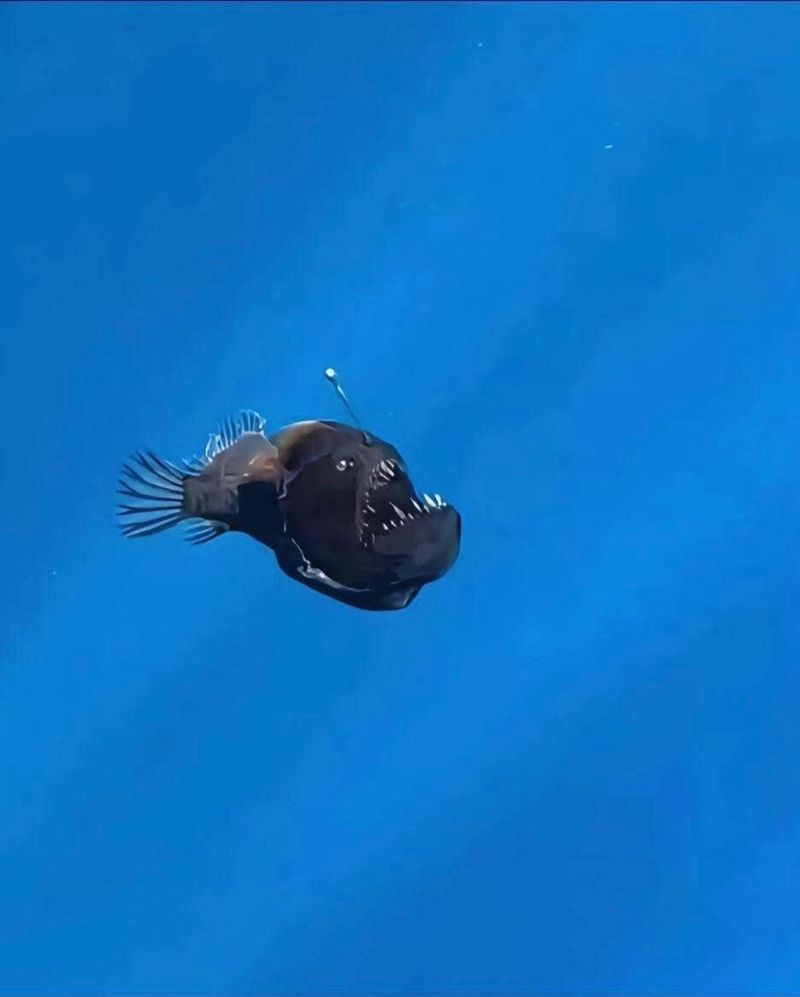
Anglerfish are the celebrities of the deep sea, known for their ghastly looks and peculiar method of catching prey. With a luminescent lure protruding from their heads, they attract unsuspecting victims in the pitch-black ocean depths. Picture a creature so uniquely equipped with a natural fishing rod; it’s almost as if nature has a sense of humor.
Despite their fearsome appearance, anglerfish are not as large as one might think, usually growing to about a foot in length. Their mouths are filled with sharp, translucent teeth that can seem as if they’ve been cut straight from a horror movie. Yet, their purpose is purely practical, enabling them to snare prey in a world where meals are scarce.
The mating ritual of the anglerfish is just as bizarre as its appearance. Males, much smaller and less terrifying, attach themselves to females, essentially becoming a parasitic mate. This unconventional approach is a testament to the extraordinary ways life evolves in the ocean’s abyss. Here, survival demands creativity, and the anglerfish is a prime example of nature’s ingenuity.
2. Gulper Eel
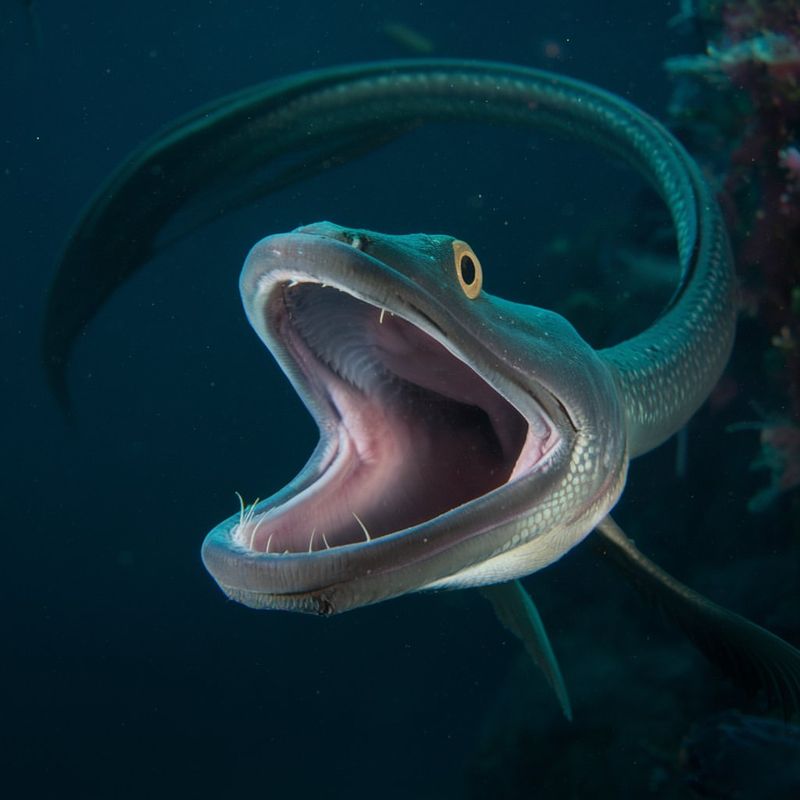
Imagine a creature that looks as if it was designed by an over-eager cartoonist. The gulper eel’s most striking feature is its enormous mouth, which seems disproportionate to its slender body and whip-like tail. This oversized jaw allows it to swallow prey much larger than itself, a handy adaptation in an environment where food is hard to come by.
While the gulper eel might not win any beauty contests, it certainly grabs attention with its adaptability. Its body is capable of expanding, accommodating surprisingly large meals, almost like an elastic lunchbox of the sea. The eel’s tail, long and thin, serves as a counterbalance to its massive maw, giving it a peculiar yet effective design.
Living in the dark depths, the gulper eel’s diet remains somewhat mysterious, though it is believed to feed on crustaceans and small fish. Its lack of pigmentation and bioluminescent organs hint at its lifestyle in the depths, a place where sunlight is but a myth. In a world of endless night, the gulper eel’s unique features allow it to thrive where others might falter.
3. Vampire Squid
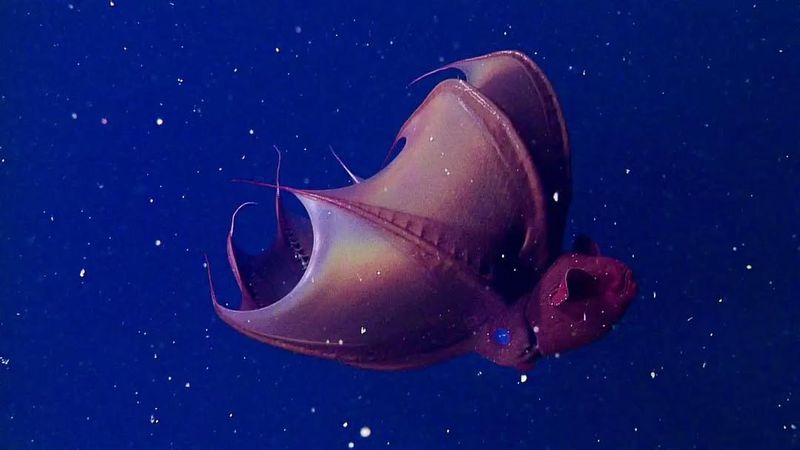
With a name like vampire squid, you’d expect a creature of myth, yet this real-life marvel is as intriguing as it sounds. The vampire squid’s appearance is nothing short of theatrical, with its cloak-like webbing and red eyes that seem to glow in the dark ocean depths. Its scientific name, Vampyroteuthis infernalis, translates to “vampire squid from hell,” a fitting title for such a dramatic being.
Despite its fearsome name, the vampire squid is more of a gentle scavenger than a bloodthirsty predator. Feeding primarily on marine snow, a mix of detritus and organic debris falling from the upper layers of the ocean, it survives in the low-oxygen environment of the deep sea. This unique dietary habit is well-suited to its habitat, where traditional prey is scarce.
The vampire squid’s method of defense is as fascinating as its lifestyle. Instead of ink, it ejects a bioluminescent mucus to confuse potential predators. This light show in the ocean’s midnight zone is a testament to the vampire squid’s resourcefulness in avoiding becoming someone else’s meal. It’s an elegant solution in a world where every encounter can mean life or death.
4. Dumbo Octopus
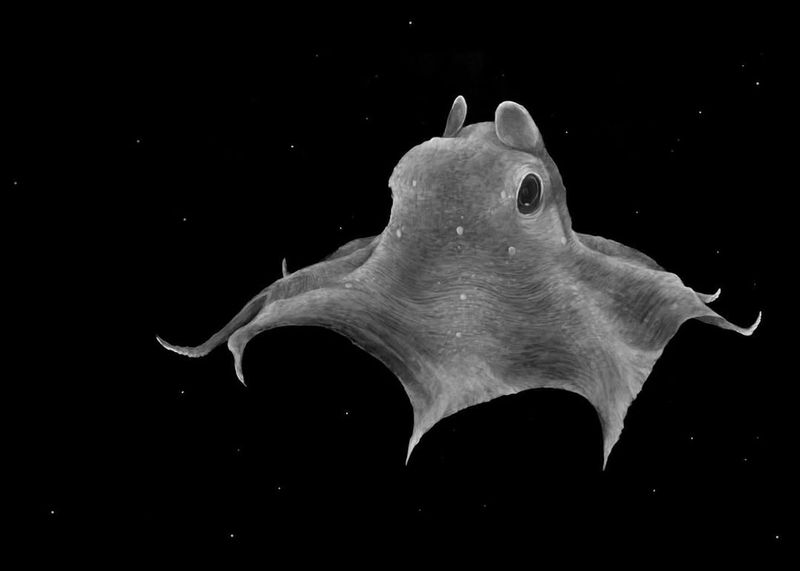
Earning its name from its distinct fins that resemble the ears of Disney’s beloved elephant, the dumbo octopus is the epitome of deep-sea charm. Unlike its more common relatives, this octopus chooses the ocean floor as its playground, gliding gracefully above it with an elegance that seems almost out of place in such a harsh environment.
The dumbo octopus navigates the deep sea using its ear-like fins, which give it an almost whimsical appearance. Its unique method of movement is not just for show; it allows the octopus to hover and maneuver with precision, a crucial skill when hunting for food. The soft body of this octopus complements its gentle way of life, equipped to handle the pressures of the deep sea.
Living thousands of meters below the surface, the dumbo octopus feeds on snails, worms, and other small organisms. It swallows its prey whole, a technique that suits its leisurely lifestyle. With its enchanting looks and serene demeanor, the dumbo octopus is a captivating reminder of the tranquility that can exist even in the ocean’s most remote corners.
5. Goblin Shark
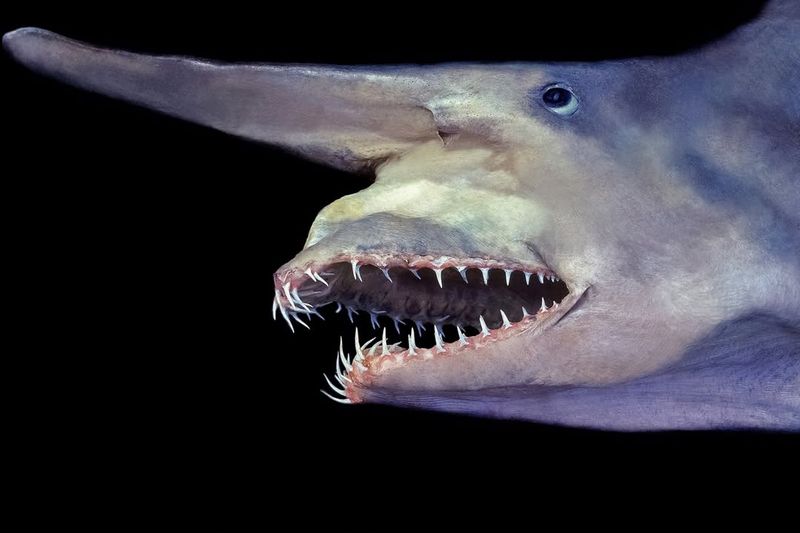
The goblin shark could easily be mistaken for a creature from a sci-fi thriller, with its elongated snout and protruding jaws lined with needle-like teeth. This elusive predator patrols the deep-sea domain, where its peculiar features serve as tools of survival in an unforgiving realm.
Famed for its ability to extend its jaws outward in a flash, the goblin shark can snatch prey with shocking speed. This rapid bite is a remarkable adaptation, allowing it to catch swift-moving fish and cephalopods in the darkness. Its snout, equipped with electroreceptors, helps detect the faintest electrical signals from potential prey, making it a formidable hunter.
Despite its fearsome appearance, encounters with the goblin shark are rare, as it dwells in depths where few humans venture. Its pinkish-grey skin and ghostly features add to its mystique, lending it an almost spectral presence in the murky waters. The goblin shark remains a symbol of the deep sea’s hidden mysteries, a prehistoric predator thriving in the shadows of the ocean.
6. Blobfish
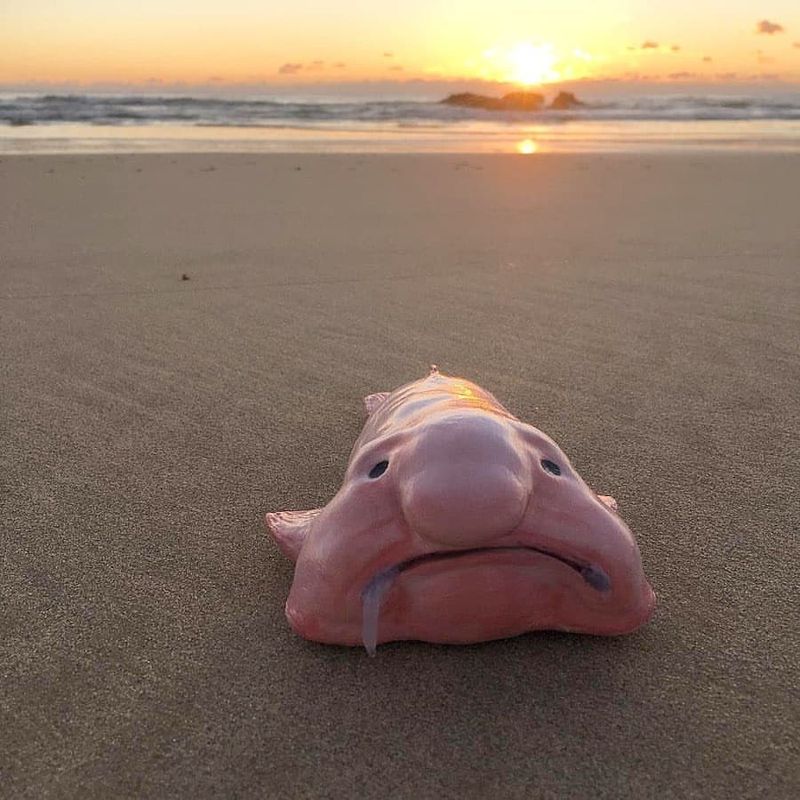
The blobfish, often dubbed the ‘world’s ugliest animal,’ is a master of soft-bodied survival in the deep sea. Its gelatinous form may not win beauty pageants, but it provides the perfect solution to living under extreme pressure. Floating effortlessly above the ocean floor, the blobfish’s unique physique is more than just a funny face.
Inhabiting the depths off the coasts of Australia and New Zealand, the blobfish thrives where other fish cannot. Its body, lacking muscle, is mainly a gelatinous mass, allowing it to withstand high pressures without being crushed. This structure also means the blobfish doesn’t need much energy to stay buoyant, conserving resources in an environment where food is scarce.
Despite its less-than-glamorous appearance, the blobfish’s lifestyle is one of efficiency. Feeding on small mollusks and crustaceans, it ambushes its prey with minimal movement. The blobfish’s endearing expression has made it a viral sensation, proving that even the strangest creatures can capture hearts. This comical sea dweller reminds us that in nature, function often trumps form, and beauty is truly in the eye of the beholder.
7. Giant Isopod
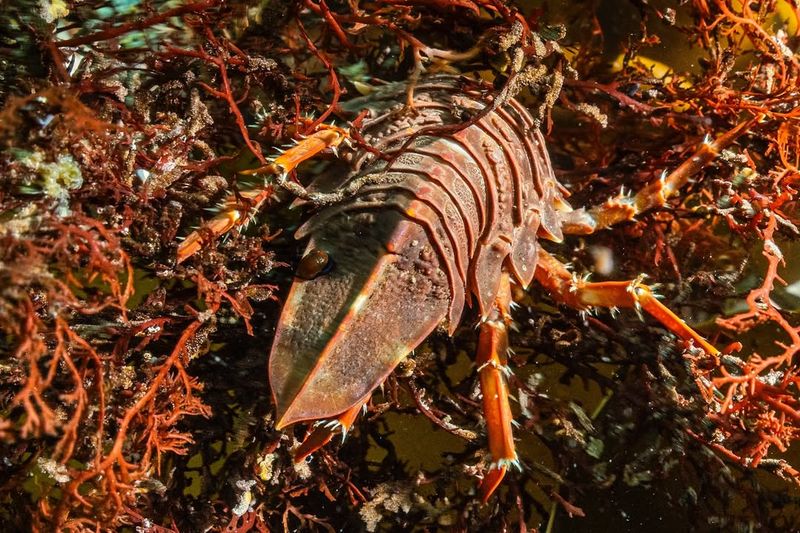
If you’ve ever wondered what a pillbug would look like if it went through a growth spurt, look no further than the giant isopod. This oversized crustacean is a testament to the diversity of life that exists in the ocean’s depths. Resembling a bug from a sci-fi movie, its armored body and numerous legs make it a peculiar yet fascinating creature.
Giant isopods inhabit the cold, deep waters of the Atlantic, Pacific, and Indian Oceans. Their size is an adaptation to the extreme pressure and low temperatures of their habitat, a phenomenon known as deep-sea gigantism. This adaptation allows them to thrive in an environment that is as inhospitable as it is mysterious.
In terms of diet, giant isopods are the opportunists of the sea floor. They feast on dead marine animals, scavenging the ocean’s bottom for any meal that floats their way. Their ability to survive for long periods without food is a testament to their resilience. With their prehistoric looks and tenacious lifestyle, giant isopods stand as a reminder of the ocean’s untamed wildness and the adaptability of life.
8. Frilled Shark
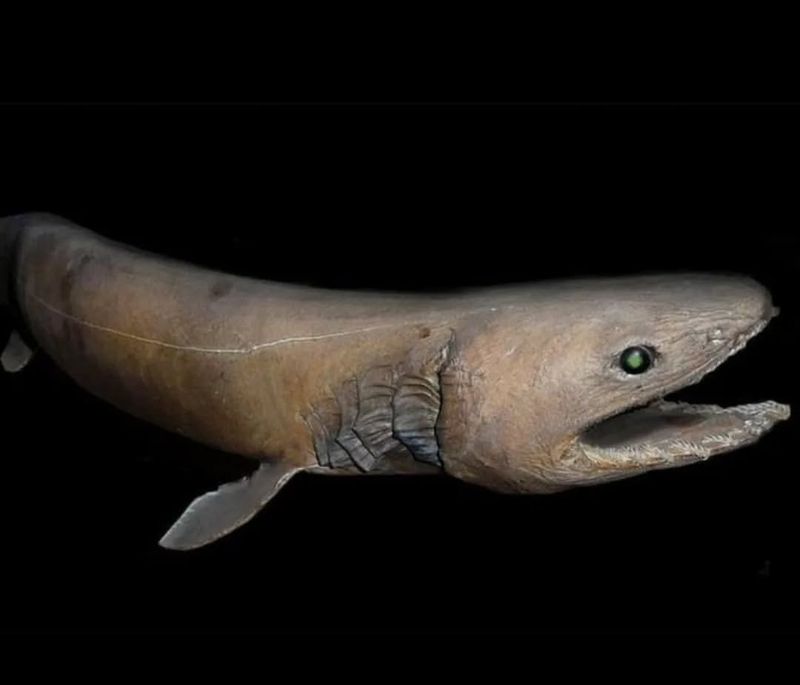
The frilled shark is a genuine living fossil, with a lineage dating back 80 million years. Its long, eel-like body and frilled gills give it a serpentine appearance, earning it a spot among the most intriguing aquatic creatures. This ancient shark glides through the deep, a relic of a time long past, carrying with it the mysteries of its prehistoric ancestors.
Frilled sharks can be found in the depths of the Atlantic and Pacific Oceans, where their elusive nature and deep habitats make sightings rare. Their flexible jaws enable them to swallow prey whole, a useful adaptation for capturing squid and other cephalopods in the sparse deep-sea environment. This feeding strategy, combined with its sharp, trident-shaped teeth, makes it an effective hunter.
Despite its intimidating features, the frilled shark poses little threat to humans, as it resides far beyond the reach of most divers. Its ghostly presence is a window into the ocean’s ancient past, a living reminder of the creatures that once roamed the world’s waters. The frilled shark remains a testament to the deep sea’s untapped history and the evolution of life on Earth.
9. Yeti Crab

The yeti crab, with its furry claws and unique habitat, is a standout among deep-sea crustaceans. Discovered near hydrothermal vents in the Southern Pacific Ocean, this peculiar creature appears as if it’s sporting a cozy pair of mittens, courtesy of its hairy pincers.
These claws are more than just for show; they play an essential role in the crab’s survival. Covered in bacteria, the hairs help the yeti crab harvest its primary food source. By cultivating bacteria on its claws, the crab has adapted to thrive in a harsh environment where traditional food sources are limited. It performs a sort of ‘farming’ that’s as bizarre as it is innovative.
The yeti crab’s choice of residence adds another layer to its mystique. Living near hydrothermal vents, it endures extreme temperatures and toxic chemicals that would be inhospitable to most life forms. This environment, coupled with its unique adaptations, makes the yeti crab a fascinating subject for scientists exploring the limits of life on Earth. It’s a creature that embodies resilience, showcasing life’s ability to flourish against the odds.
10. Sea Pen
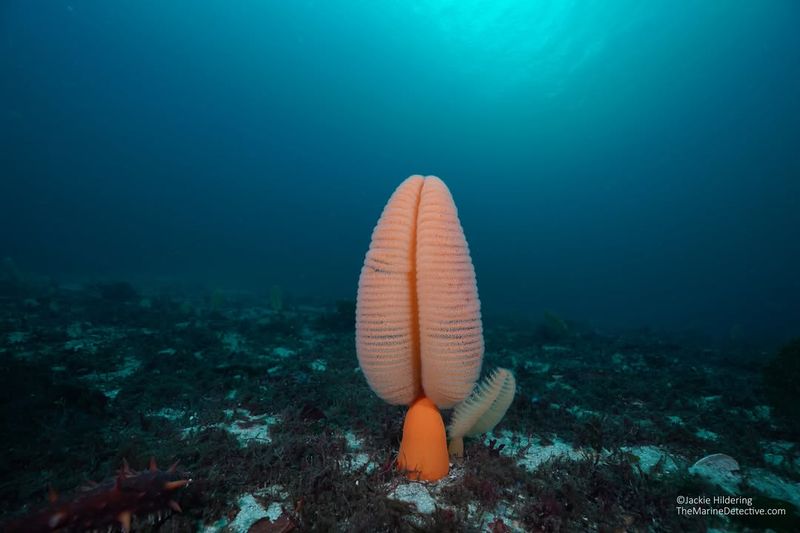
Sea pens, with their graceful, feather-like appearance, resemble something out of a fantastical underwater forest. Despite their plant-like looks, these creatures are actually colonies of polyps, working together as a single organism. Anchored to the ocean floor, they sway gently with the currents, painting a serene picture in the deep sea.
The structure of a sea pen is as practical as it is beautiful. Its central stalk, often glowing with a subtle bioluminescence, supports numerous branches where polyps capture plankton and detritus. This communal feeding system highlights the intricate cooperation within the colony, a testament to the power of teamwork.
Sea pens are found in oceans worldwide, from shallow waters to depths of over 2,000 meters. Their ability to glow in the dark ocean is both a defense mechanism and a way to attract prey, showcasing an elegant blend of form and function. As a symbol of unity and adaptability, sea pens remind us of the intricate connections and delicate balances that sustain life beneath the waves.
11. Leafy Seadragon
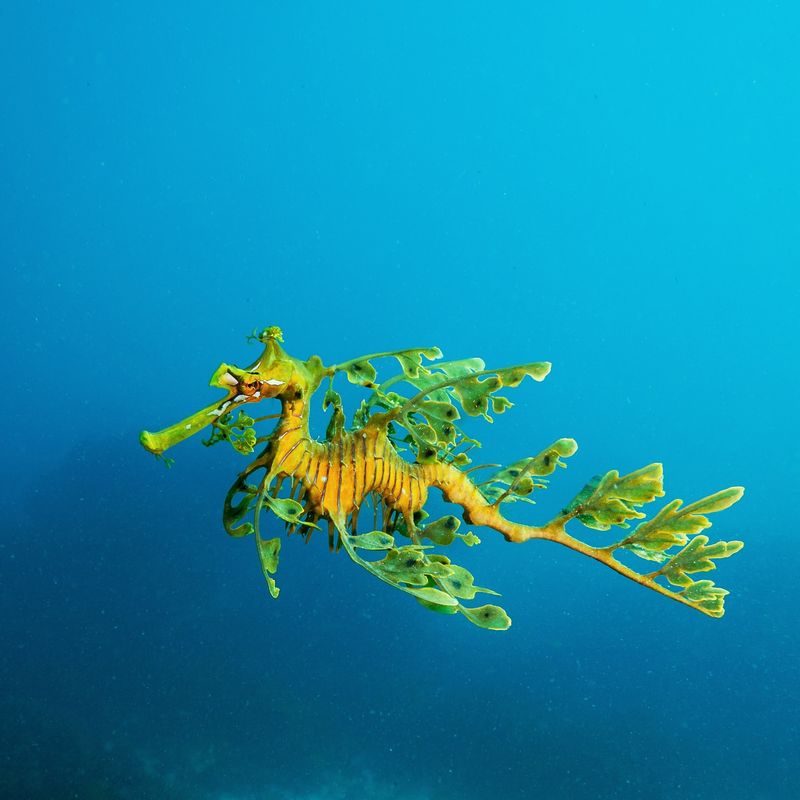
This remarkable fish, found off the southern and western coasts of Australia, sports leaf-like appendages that provide the perfect camouflage from predators and unsuspecting prey alike.
Its delicate appearance belies a robust design, with a body capable of withstanding the dynamic ocean environment. The leafy seadragon’s unique shape and coloration make it nearly invisible in its natural surroundings, a strategy that’s both artful and effective. This camouflage is so convincing that it’s often mistaken for drifting seaweed by both predators and humans.
Feeding on small crustaceans and plankton, the leafy seadragon employs a gentle approach, using its elongated snout to suck up prey. This non-aggressive feeding style aligns with its tranquil demeanor, floating through the water with a serene elegance. As a symbol of harmony and balance, the leafy seadragon embodies the beauty of nature’s artistry, a testament to evolution’s ability to craft works of art in the pursuit of survival.
12. Barreleye Fish
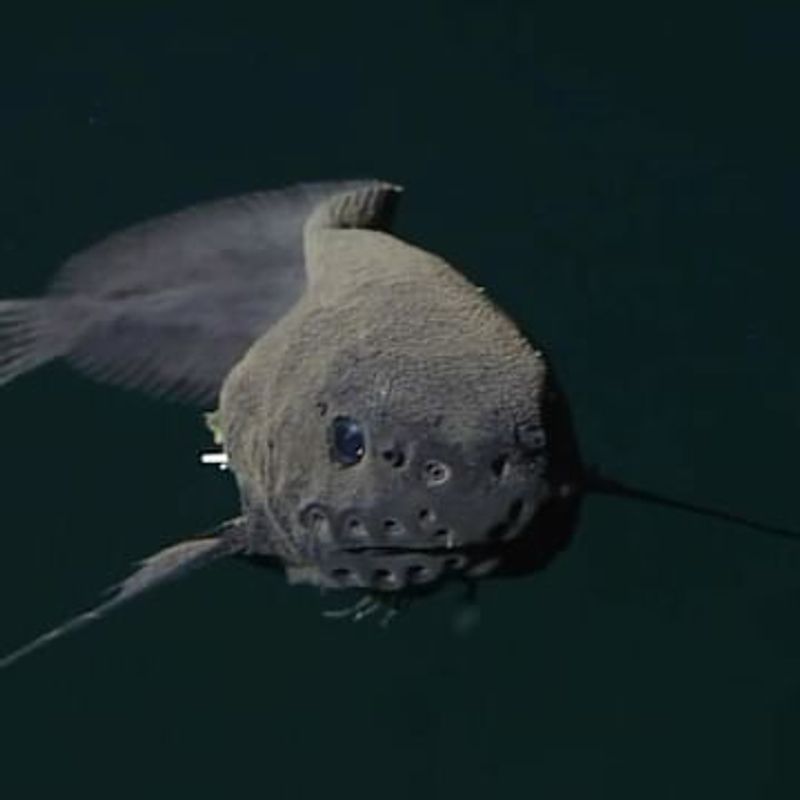
The barreleye fish, with its transparent head and tubular eyes, offers a glimpse into the complexities of deep-sea adaptation. Picture a creature so unique that it seems to defy logic, with eyes that peer through its own forehead to spot prey. This surreal fish is a master of visual ingenuity in the ocean’s depths.
Its see-through head is not just for show; it provides the barreleye with a 360-degree view of its surroundings. The tubular eyes can rotate within the head, allowing the fish to track prey above while still maintaining awareness of its environment. This feature is particularly useful in the dark waters where it resides, where food is scarce and predators lurk.
Living in the deep Atlantic and Pacific Oceans, the barreleye’s diet primarily consists of small jellyfish and zooplankton. Its unusual anatomy reflects the challenges of its habitat, where light is minimal, and survival demands efficiency. The barreleye fish stands as a testament to nature’s creativity, a marvel of biological engineering that thrives in one of Earth’s most extreme environments.
13. Fangtooth Fish
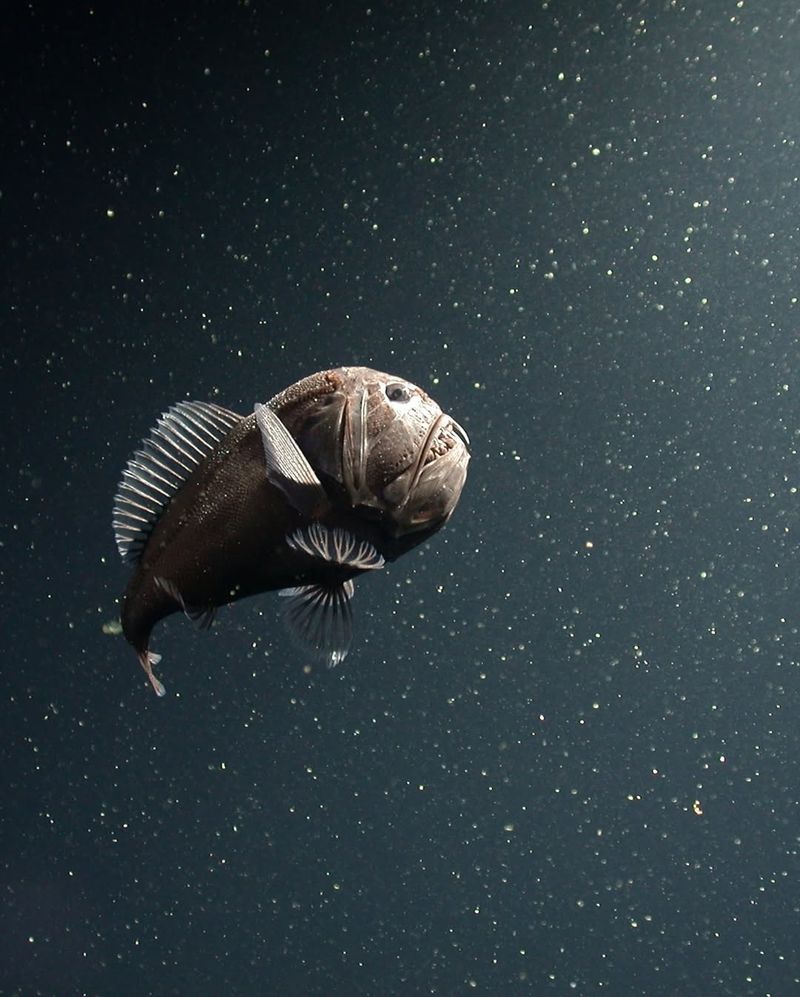
With its menacing appearance and disproportionately large teeth, the fangtooth fish is a nightmare come to life. This small but fierce predator roams the deep sea, equipped with one of the most fearsome sets of dentures in the ocean.
Fangtooth fish are not particularly large, averaging only about six inches in length. However, their teeth are the largest, relative to body size, of any fish in the sea, a feature that gives them a daunting grin. These impressive chompers are perfectly adapted for catching and holding onto prey in the dark and unforgiving depths.
Living in the deep waters of both the Atlantic and Pacific Oceans, fangtooths are solitary hunters, relying on their keen senses and sharp teeth to capture fish and squid. Their survival strategies highlight the harsh realities of the deep sea, where every meal is hard-earned. Despite their fearsome look, fangtooth fish are harmless to humans, existing far below the depths typically explored. They stand as a reminder of the ocean’s vast and mysterious world, where even the tiniest of creatures can wield power.
14. Dragonfish
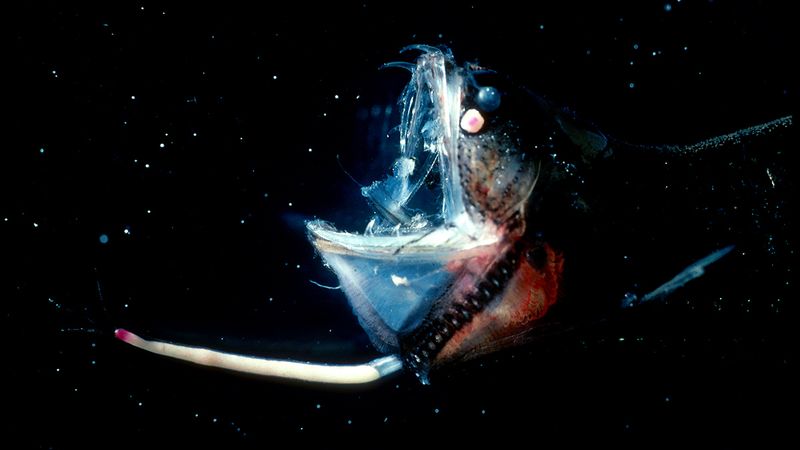
The name dragonfish evokes images of mythical beasts, and this real-life creature doesn’t disappoint. With its glowing spots and fearsome appearance, the dragonfish is well-equipped for the challenges of deep-sea life. It’s a marvel of natural engineering, adapting to the abyss where few can survive.
Bioluminescence is the dragonfish’s secret weapon, allowing it to communicate, attract mates, and lure prey in the darkness. Its body is covered in light-producing organs called photophores, creating a dazzling display in the otherwise dimly lit ocean. This sparkling armor is both a tool for hunting and a tactic for avoiding predators.
Residing in the deep waters of the Atlantic and Pacific Oceans, the dragonfish preys on small fish and crustaceans. Its needle-like teeth and extendable jaw enable it to snare elusive prey with precision. Despite its fearsome look, the dragonfish’s size is modest, usually measuring less than a foot. Its ability to glow in complete darkness makes it a beacon of intrigue, a living testament to nature’s inventiveness in the pursuit of survival in the deep.
